Prosumer Flexibility: A Comprehensive State-of-the-Art Review and Scientometric Analysis
Abstract
1. Introduction
Contributions
- Robust collection, analysis, and synthesis of state-of-the-art peer-reviewed literature surrounding the growing field of prosumer flexibility;
- The application of various textual analysis tools to a large body of literature to distil relevant insights;
- A discussion about the opportunities, challenges, and trends of prosumer flexibility.
2. Demand Side Flexibility
3. Methodology Followed
3.1. Textual Analysis
3.2. Tools and Datasets Used
4. Scientometric Analysis Results
4.1. Prosumer Flexibility Over Time
4.2. Who is Researching Prosumer Flexibility?
4.3. Abstract Analysis
4.4. Keyword Analysis
5. Key Issues from the Literature
5.1. Smart Grid
“Strategic Deployment Document for Europe’s Electricity Networks of the Future”.
5.2. Demand Response
“changes in electric usage by end-use customers from their normal consumption patterns in response to changes in the price of electricity over time or to incentives payments designed to induce lower electricity use at the time of high wholesale market prices or when the system reliability is jeopardized” [57].
5.3. Microgrid
“A group of interconnected loads and distributed energy resources within a clearly defined electrical boundary which acts as a single controllable entity with respect to the grid. A microgrid can disconnect from the grid to enable it to operate in both grid-connected or islanded mode” [69].
5.4. Prosumer
5.5. Distributed Energy Resources
- Smart grid
- Energy transition
- Distributed generation
- Smart meters
- Solar PV
- Battery storage
- Blockchain
5.5.1. Energy Storage Systems
5.5.2. Thermal Loads
5.5.3. Heat Pumps
5.5.4. Electric Vehicles
5.5.5. PV Systems
5.5.6. General Issues to Consider
6. Trends Identified
7. Conclusions
- Inadequate markets to fully harness the potential of prosumers. Current markets lack both the scale and scope to be fully inclusive to all participants in the energy sector. This will require a significant change in both what products energy markets offer as well as the conditions to entry of these markets. These changes to the market rules are slowly happening as regulators see the significant additional value that prosumers can provide to markets;
- Tariff and regulatory regimes that do not incentivise DER ownership by consumers. Special attention should be paid to designing regulations which incentivise the adoption of DERs by prosumers in a controlled manner and these incentives should be aware of the behavioural and societal effects that a rise in prosumers may bring. This type of regulation is beginning to emerge, especially in various EU member states as new regulatory regimes are introduced which actively promote consumer participation;
- A lack of information provided to consumers. Providing easily understandable and accurate information to consumers relating to both the technical and financial aspects of owning DERs is key to allow consumers to make informed choices;
- Inadequate business models and financing instruments. With the emergence of prosumers, novel business models and financing instruments are needed in order to make DER ownership easy and attractive to consumers. In this regard, regulatory agencies have a difficult task ahead. These agencies can spur business model innovation by introducing new regulations, but will still need to ensure that these regulations still protect the best interests of consumers;
- Privacy and data security concerns. Society is grappling with the issue of personal data use by third parties. The energy sector, with its tight relationship to ICT systems, will also have to devise mechanisms to ensure that consumer’s data is safe, secure and only used for the intended purposes. This area will be a key obstacle to overcome if the potential of active consumer participation is to be realised.
Author Contributions
Funding
Conflicts of Interest
References
- Villar, J.; Bessa, R.; Matos, M. Flexibility products and markets: Literature review. Electr. Power Syst. Res. 2018, 154, 329–340. [Google Scholar] [CrossRef]
- Heggarty, T.; Bourmaud, J.-Y.; Girard, R.; Kariniotakis, G. Multi-temporal assessment of power system flexibility requirement. Appl. Energy 2019, 238, 1327–1336. [Google Scholar] [CrossRef]
- Cruz, M.R.M.; Fitiwi, D.Z.; Santos, S.F.; Catalão, J.P.S. A comprehensive survey of flexibility options for supporting the low-carbon energy future. Renew. Sustain. Energy Rev. 2018, 97, 338–353. [Google Scholar] [CrossRef]
- Lannoye, E.; Flynn, D.; O’Malley, M. Evaluation of Power System Flexibility. IEEE Trans. Power Syst. 2012, 27, 922–931. [Google Scholar] [CrossRef]
- Grijalva, S.; Tariq, M.U. Prosumer-based smart grid architecture enables a flat, sustainable electricity industry. In Proceedings of the ISGT 2011, Anaheim, CA, USA, 17–19 January 2011. [Google Scholar]
- Liu, N.; Yu, X.; Wang, C.; Li, C.; Ma, L.; Lei, J. Energy-Sharing Model with Price-Based Demand Response for Microgrids of Peer-to-Peer Prosumers. IEEE Trans. Power Syst. 2017, 32, 3569–3583. [Google Scholar] [CrossRef]
- Tulabing, R.; Yin, R.; DeForest, N.; Li, Y.; Wang, K.; Yong, T.; Stadler, M. Modeling study on flexible load’s demand response potentials for providing ancillary services at the substation level. Electr. Power Syst. Res. 2016, 140, 240–252. [Google Scholar] [CrossRef]
- Kohlhepp, P.; Harb, H.; Wolisz, H.; Waczowicz, S.; Müller, D.; Hagenmeyer, V. Large-scale grid integration of residential thermal energy storages as demand-side flexibility resource: A review of international field studies. Renew. Sustain. Energy Rev. 2019, 101, 527–547. [Google Scholar] [CrossRef]
- Koliou, E.; Bartusch, C.; Picciariello, A.; Eklund, T.; Söder, L.; Hakvoort, R.A. Quantifying distribution-system operators’ economic incentives to promote residential demand response. Util. Policy 2015, 35, 28–40. [Google Scholar] [CrossRef]
- Noor, S.; Yang, W.; Guo, M.; van Dam, K.H.; Wang, X. Energy Demand Side Management within micro-grid networks enhanced by blockchain. Appl. Energy 2018, 228, 1385–1398. [Google Scholar] [CrossRef]
- Steriotis, K.; Tsaousoglou, G.; Efthymiopoulos, N.; Makris, P.; Varvarigos, E.M. A novel behavioral real time pricing scheme for the active energy consumers’ participation in emerging flexibility markets. Sustain. Energy Grids Netw. 2018, 16, 14–27. [Google Scholar] [CrossRef]
- Kubli, M.; Loock, M.; Wüstenhagen, R. The flexible prosumer: Measuring the willingness to co-create distributed flexibility. Energy Policy 2018, 114, 540–548. [Google Scholar] [CrossRef]
- Pinto, T.; Faia, R.; Ghazvini, M.A.F.; Soares, J.; Corchado, J.M.; Vale, Z. Decision support for small players negotiations under a transactive energy framework. IEEE Trans. Power Syst. 2018, 34, 4015–4023. [Google Scholar] [CrossRef]
- Directorate-General for Energy (European Commission). Clean Energy for All Europeans; European Commission: Brussels, Belgium, 2019. [Google Scholar]
- Aduda, K.O.; Labeodan, T.; Zeiler, W.; Boxem, G. Demand side flexibility coordination in office buildings: A framework and case study application. Sustain. Cities Soc. 2017, 29, 139–158. [Google Scholar] [CrossRef]
- Roos, A.; Ottesen, S.Ø.; Bolkesjø, T.F. Modeling Consumer Flexibility of an Aggregator Participating in the Wholesale Power Market and the Regulation Capacity Market. Energy Procedia 2014, 58, 79–86. [Google Scholar] [CrossRef]
- Shafie-Khah, M.; Siano, P. A Stochastic Home Energy Management System Considering Satisfaction Cost and Response Fatigue. IEEE Trans. Ind. Inform. 2018, 14, 629–638. [Google Scholar] [CrossRef]
- Parrish, B.; Gross, R.; Heptonstall, P. On demand: Can demand response live up to expectations in managing electricity systems? Energy Res. Soc. Sci. 2019, 51, 107–118. [Google Scholar] [CrossRef]
- Zhou, B.; Li, W.; Chan, K.W.; Cao, Y.; Kuang, Y.; Liu, X.; Wang, X. Smart home energy management systems: Concept, configurations, and scheduling strategies. Renew. Sustain. Energy Rev. 2016, 61, 30–40. [Google Scholar] [CrossRef]
- Good, N. Using behavioural economic theory in modelling of demand response. Appl. Energy 2019, 239, 107–116. [Google Scholar] [CrossRef]
- Palm, J.; Eidenskog, M.; Luthander, R. Sufficiency, change, and flexibility: Critically examining the energy consumption profiles of solar PV prosumers in Sweden. Energy Res. Soc. Sci. 2018, 39, 12–18. [Google Scholar] [CrossRef]
- Carreiro, A.M.; Jorge, H.M.; Antunes, C.H. Energy management systems aggregators: A literature survey. Renew. Sustain. Energy Rev. 2017, 73, 1160–1172. [Google Scholar] [CrossRef]
- Lipari, G.; Rosario, G.D.; Corchero, C.; Ponci, F.; Monti, A. A real-time commercial aggregator for distributed energy resources flexibility management. Sustain. Energy Grids Netw. 2018, 15, 63–75. [Google Scholar] [CrossRef]
- Alizadeh, M.; Scaglione, A.; Goldsmith, A.; Kesidis, G. Capturing aggregate flexibility in demand response. In Proceedings of the 53rd IEEE Conference on Decision and Control, Los Angeles, CA, USA, 15–17 December 2014; pp. 6439–6445. [Google Scholar]
- Agnetis, A.; Dellino, G.; de Pascale, G.; Innocenti, G.; Pranzo, M.; Vicino, A. Optimization models for consumer flexibility aggregation in smart grids: The ADDRESS approach. In Proceedings of the 2011 IEEE First International Workshop on Smart Grid Modeling and Simulation (SGMS), Brussels, Belgium, 17 October 2011; pp. 96–101. [Google Scholar]
- Das, C.K.; Bass, O.; Kothapalli, G.; Mahmoud, T.S.; Habibi, D. Overview of energy storage systems in distribution networks: Placement, sizing, operation, and power quality. Renew. Sustain. Energy Rev. 2018, 91, 1205–1230. [Google Scholar] [CrossRef]
- Yazdaninejadi, A.; Hamidi, A.; Golshannavaz, S.; Aminifar, F.; Teimourzadeh, S. Impact of inverter-based DERs integration on protection, control, operation, and planning of electrical distribution grids. Electr. J. 2019, 32, 43–56. [Google Scholar] [CrossRef]
- SAS Institute Inc. SAS Visual Text Analytics 8.5: User’s Guide; SAS Institute Inc.: Cary, NC, USA, 2019. [Google Scholar]
- Van Eck, N.J.; Waltman, L. Software survey: VOSviewer, a computer program for bibliometric mapping. Scientometrics 2010, 84, 523–538. [Google Scholar] [CrossRef]
- Söder, L.; Lund, P.D.; Koduvere, H.; Bolkesjø, T.F.; Rossebø, G.H.; Rosenlund-Soysal, E.; Skytte, K.; Katz, J.; Blumberga, D. A review of demand side flexibility potential in Northern Europe. Renew. Sustain. Energy Rev. 2018, 91, 654–664. [Google Scholar] [CrossRef]
- Karunathilake, H.; Hewage, K.; Sadiq, R. Opportunities and challenges in energy demand reduction for Canadian residential sector: A review. Renew. Sustain. Energy Rev. 2018, 82, 2005–2016. [Google Scholar] [CrossRef]
- Jin, X.; Wu, Q.; Jia, H. Local flexibility markets: Literature review on concepts, models and clearing methods. Appl. Energy 2020, 261, 114387. [Google Scholar] [CrossRef]
- Houwing, M.; Ajah, A.N.; Heijnen, P.W.; Bouwmans, I.; Herder, P.M. Uncertainties in the design and operation of distributed energy resources: The case of micro-CHP systems. Energy 2008, 33, 1518–1536. [Google Scholar] [CrossRef]
- Zhang, Y.; Chen, W.; Gao, W. A survey on the development status and challenges of smart grids in main driver countries. Renew. Sustain. Energy Rev. 2017, 79, 137–147. [Google Scholar] [CrossRef]
- Tuballa, M.L.; Abundo, M.L. A review of the development of Smart Grid technologies. Renew. Sustain. Energy Rev. 2016, 59, 710–725. [Google Scholar] [CrossRef]
- Dileep, G. A survey on smart grid technologies and applications. Renew. Energy 2020, 146, 2589–2625. [Google Scholar] [CrossRef]
- Nabuurs, P. EUROPA—SmartGrids Strategic Deployment Document Finalised | SETIS—European Commission. 2010. Available online: https://setis.ec.europa.eu/newsroom/news/smartgrids-strategic-deployment-document-finalised (accessed on 14 February 2020).
- Haque, A.N.M.M.; Vo, T.H.; Nguyen, P.H. Distributed intelligence: Unleashing flexibilities for congestion management in smart distribution networks (Invited paper). In Proceedings of the 2016 IEEE International Conference on Sustainable Energy Technologies (ICSET), Hanoi, Vietnam, 14–16 November 2016; pp. 407–413. [Google Scholar]
- Lund, P.D.; Lindgren, J.; Mikkola, J.; Salpakari, J. Review of energy system flexibility measures to enable high levels of variable renewable electricity. Renew. Sustain. Energy Rev. 2015, 45, 785–807. [Google Scholar] [CrossRef]
- Thakur, J.; Chakraborty, B. Demand side management in developing nations: A mitigating tool for energy imbalance and peak load management. Energy 2016, 114, 895–912. [Google Scholar] [CrossRef]
- González, D.M.; Myrzik, J. Probabilistic determination of the operational flexibility of active distribution networks with high penetration of full-converter interfaced renewable distributed generation units. In Proceedings of the 2015 50th International Universities Power Engineering Conference (UPEC), Stoke on Trent, UK, 1–4 September 2015; pp. 1–5. [Google Scholar]
- Colak, I.; Bayindir, R.; Fulli, G.; Tekin, I.; Demirtas, K.; Covrig, C.-F. Smart grid opportunities and applications in Turkey. Renew. Sustain. Energy Rev. 2014, 33, 344–352. [Google Scholar] [CrossRef]
- Ottesen, S.Ø.; Tomasgard, A.; Fleten, S.-E. Multi market bidding strategies for demand side flexibility aggregators in electricity markets. Energy 2018, 149, 120–134. [Google Scholar] [CrossRef]
- Schick, L.; Gad, C. Flexible and inflexible energy engagements—A study of the Danish Smart Grid Strategy. Energy Res. Soc. Sci. 2015, 9, 51–59. [Google Scholar] [CrossRef]
- Krishan, O.; Suhag, S. An updated review of energy storage systems: Classification and applications in distributed generation power systems incorporating renewable energy resources. Int. J. Energy Res. 2019, 43, 6171–6210. [Google Scholar] [CrossRef]
- Wang, J.; Zhong, H.; Ma, Z.; Xia, Q.; Kang, C. Review and prospect of integrated demand response in the multi-energy system. Appl. Energy 2017, 202, 772–782. [Google Scholar] [CrossRef]
- Martinez-Pabon, M.; Eveleigh, T.; Tanju, B. Smart Meter Data Analytics for Optimal Customer Selection in Demand Response Programs. Energy Procedia 2017, 107, 49–59. [Google Scholar] [CrossRef]
- Leiva, J.; Palacios, A.; Aguado, J.A. Smart metering trends, implications and necessities: A policy review. Renew. Sustain. Energy Rev. 2016, 55, 227–233. [Google Scholar] [CrossRef]
- Shareef, H.; Ahmed, M.S.; Mohamed, A.; al Hassan, E. Review on Home Energy Management System Considering Demand Responses, Smart Technologies, and Intelligent Controllers. IEEE Access 2018, 6, 24498–24509. [Google Scholar] [CrossRef]
- Muratori, M.; Rizzoni, G. Residential Demand Response: Dynamic Energy Management and Time-Varying Electricity Pricing. IEEE Trans. Power Syst. 2016, 31, 1108–1117. [Google Scholar] [CrossRef]
- Javadi, M.S.; Lotfi, M.; Gough, M.; EsmaeelNezhad, A.; Catalao, J.P.S. Optimal Spinning Reserve Allocation in Presence of Electrical Energy Storage Devices and Renewable Energy Sources. In Proceedings of the 2019 IEEE International Conference on Environment and Electrical Engineering and 2019 IEEE Industrial and Commercial Power Systems Europe, Genova, Italy, 11–14 June 2019. [Google Scholar]
- Park, C.; Kim, Y.; Jeong, M. Influencing factors on risk perception of IoT-based home energy management services. Telemat. Inform. 2018, 35, 2355–2365. [Google Scholar] [CrossRef]
- Al-Ali, A.R.; Zualkernan, I.A.; Rashid, M.; Gupta, R.; Alikarar, M. A smart home energy management system using IoT and big data analytics approach. IEEE Trans. Consum. Electron. 2017, 63, 426–434. [Google Scholar] [CrossRef]
- Zong, Y.; Su, W.; Wang, J.; Rodek, J.K.; Jiang, C.; Christensen, M.H.; You, S.; Zhou, Y.; Mu, S. Model Predictive Control for Smart Buildings to Provide the Demand Side Flexibility in the Multi-Carrier Energy Context: Current Status, Pros and Cons, Feasibility and Barriers. Energy Procedia 2019, 158, 3026–3031. [Google Scholar] [CrossRef]
- Davatgaran, V.; Saniei, M.; Mortazavi, S.S. Smart distribution system management considering electrical and thermal demand response of energy hubs. Energy 2019, 169, 38–49. [Google Scholar] [CrossRef]
- Jordehi, A.R. Optimisation of demand response in electric power systems, a review. Renew. Sustain. Energy Rev. 2019, 103, 308–319. [Google Scholar] [CrossRef]
- U.S. Federal Energy Regulatory Commission. Assessment of Demand Response and Advanced Metering Staff Report; U.S. Federal Energy Regulatory Commission, 2012. Available online: http://www.ferc.gov/legal/staff-reports (accessed on 17 February 2020).
- Eid, C.; Koliou, E.; Valles, M.; Reneses, J.; Hakvoort, R. Time-based pricing and electricity demand response: Existing barriers and next steps. Util. Policy 2016, 40, 15–25. [Google Scholar] [CrossRef]
- Spiliotis, K.; Gutierrez, A.I.R.; Belmans, R. Demand flexibility versus physical network expansions in distribution grids. Appl. Energy 2016, 182, 613–624. [Google Scholar] [CrossRef]
- Robert, F.C.; Sisodia, G.S.; Gopalan, S. A critical review on the utilization of storage and demand response for the implementation of renewable energy microgrids. Sustain. Cities Soc. 2018, 40, 735–745. [Google Scholar] [CrossRef]
- Lotfi, M.; Monteiro, C.; Shafie-khah, M.; Catalão, J.P.S. Evolution of demand response: A historical analysis of legislation and research trends. In Proceedings of the 2018 Twentieth International Middle East Power Systems Conference (MEPCON), Cairo, Egypt, 18–20 December 2018; pp. 968–973. [Google Scholar]
- Mansouri, S.A.; Ahmarinejad, A.; Ansarian, M.; Javadi, M.S.; Catalao, J.P.S. Stochastic planning and operation of energy hubs considering demand response programs using Benders decomposition approach. Int. J. Electr. Power Energy Syst. 2020, 120, 106030. [Google Scholar] [CrossRef]
- Arteconi, A.; Patteeuw, D.; Bruninx, K.; Delarue, E.; D’haeseleer, W.; Helsen, L. Active demand response with electric heating systems: Impact of market penetration. Appl. Energy 2016, 177, 636–648. [Google Scholar] [CrossRef]
- Ji, Y.; Rajagopal, R. Demand and flexibility of residential appliances: An empirical analysis. In Proceedings of the 2017 IEEE Global Conference on Signal and Information Processing (GlobalSIP), Montreal, QC, Canada, 14–16 November 2017; pp. 1020–1024. [Google Scholar]
- Stavrakas, V.; Papadelis, S.; Flamos, A. An agent-based model to simulate technology adoption quantifying behavioural uncertainty of consumers. Appl. Energy 2019, 255, 113795. [Google Scholar] [CrossRef]
- Becker, S.; Schober, D.; Wassermann, S. How to approach consumers’ nonmonetary evaluation of electricity supply security? The case of Germany from a multidisciplinary perspective. Util. Policy 2016, 42, 74–84. [Google Scholar] [CrossRef]
- Chamikara, M.A.P.; Bertok, P.; Liu, D.; Camtepe, S.; Khalil, I. An efficient and scalable privacy preserving algorithm for big data and data streams. Comput. Secur. 2019, 87, 101570. [Google Scholar] [CrossRef]
- Svantesson, D.; Clarke, R. Privacy and consumer risks in cloud computing. Comput. Law Secur. Rev. 2010, 26, 391–397. [Google Scholar] [CrossRef]
- Ton, D.T.; Smith, M.A. The, U.S. Department of Energy’s Microgrid Initiative. Electr. J. 2012, 25, 84–94. [Google Scholar] [CrossRef]
- Hirsch, A.; Parag, Y.; Guerrero, J. Microgrids: A review of technologies, key drivers, and outstanding issues. Renew. Sustain. Energy Rev. 2018, 90, 402–411. [Google Scholar] [CrossRef]
- Ma, L.; Liu, N.; Zhang, J.; Tushar, W.; Yuen, C. Energy Management for Joint Operation of CHP and PV Prosumers Inside a Grid-Connected Microgrid: A Game Theoretic Approach. IEEE Trans. Ind. Inform. 2016, 12, 1930–1942. [Google Scholar] [CrossRef]
- Martin-Martínez, F.; Sánchez-Miralles, A.; Rivier, M. A literature review of Microgrids: A functional layer based classification. Renew. Sustain. Energy Rev. 2016, 62, 1133–1153. [Google Scholar] [CrossRef]
- Sen, S.; Kumar, V. Microgrid modelling: A comprehensive survey. Annu. Rev. Control 2018, 46, 216–250. [Google Scholar] [CrossRef]
- Barbaro, M.; Castro, R. Design optimisation for a hybrid renewable microgrid: Application to the case of Faial island, Azores archipelago. Renew. Energy 2019. [Google Scholar] [CrossRef]
- Li, Z.; Xu, Y. Optimal coordinated energy dispatch of a multi-energy microgrid in grid-connected and islanded modes. Appl. Energy 2018, 210, 974–986. [Google Scholar] [CrossRef]
- Kim, S.; Kim, D.; Yoon, Y.T. Short-Term Operation Scheduling of a Microgrid under Variability Contracts to Preserve Grid Flexibility. Energies 2019, 12, 3587. [Google Scholar] [CrossRef]
- Ajoulabadi, A.; Ravadanegh, S.N.; Mohammadi-Ivatloo, B. Flexible scheduling of reconfigurable microgrid-based distribution networks considering demand response program. Energy 2020, 196, 117024. [Google Scholar] [CrossRef]
- Cagnano, A.; de Tuglie, E.; Mancarella, P. Microgrids: Overview and guidelines for practical implementations and operation. Appl. Energy 2020, 258, 114039. [Google Scholar] [CrossRef]
- Cornélusse, B.; Savelli, I.; Paoletti, S.; Giannitrapani, A.; Vicino, A. A community microgrid architecture with an internal local market. Appl. Energy 2019, 242, 547–560. [Google Scholar] [CrossRef]
- Ritzer, G.; Jurgenson, N. Production, Consumption, Prosumption: The nature of capitalism in the age of the digital ‘prosumer’. J. Consum. Cult. 2010, 10, 13–36. [Google Scholar] [CrossRef]
- Ritzer, G.; Dean, P.; Jurgenson, N. The Coming of Age of the Prosumer. Am. Behav. Sci. 2012. [Google Scholar] [CrossRef]
- Kotler, P. The Prosumer Movement: A New Challenge for Marketers. Available online: https:///www.acrwebsite.org/volumes/6542/volumes/v13/NA-13 (accessed on 20 April 2020).
- Zafar, R.; Mahmood, A.; Razzaq, S.; Ali, W.; Naeem, U.; Shehzad, K. Prosumer based energy management and sharing in smart grid. Renew. Sustain. Energy Rev. 2018, 82, 1675–1684. [Google Scholar] [CrossRef]
- Wang, Z.; Yu, X.; Mu, Y.; Jia, H. A distributed Peer-to-Peer energy transaction method for diversified prosumers in Urban Community Microgrid System. Appl. Energy 2020, 260, 114327. [Google Scholar] [CrossRef]
- Sousa, T.; Soares, T.; Pinson, P.; Moret, F.; Baroche, T.; Sorin, E. Peer-to-peer and community-based markets: A comprehensive review. Renew. Sustain. Energy Rev. 2019, 104, 367–378. [Google Scholar] [CrossRef]
- Iria, J.; Soares, F.; Matos, M. Optimal bidding strategy for an aggregator of prosumers in energy and secondary reserve markets. Appl. Energy 2019, 238, 1361–1372. [Google Scholar] [CrossRef]
- Hiteva, R.; Sovacool, B. Harnessing social innovation for energy justice: A business model perspective. Energy Policy 2017, 107, 631–639. [Google Scholar] [CrossRef]
- Riveros, J.Z.; Kubli, M.; Ulli-Beer, S. Prosumer communities as strategic allies for electric utilities: Exploring future decentralization trends in Switzerland. Energy Res. Soc. Sci. 2019, 57, 101219. [Google Scholar] [CrossRef]
- Sajjad, I.A.; Chicco, G.; Napoli, R. Definitions of Demand Flexibility for Aggregate Residential Loads. IEEE Trans. Smart Grid 2016, 7, 2633–2643. [Google Scholar] [CrossRef]
- Reis, I.F.G.; Gonçalves, I.; Lopes, M.A.R.; Antunes, C.H. Residential demand-side flexibility in energy communities: A combination of optimization and agent modeling approaches. In Proceedings of the 2019 International Conference on Smart Energy Systems and Technologies (SEST), Porto, Portugal, 9–11 September 2019; pp. 1–6. [Google Scholar]
- Li, X.; Chalvatzis, K.J.; Stephanides, P.; Papapostolou, C.; Kondyli, E.; Kaldellis, K.; Zafirakis, D. Bringing innovation to market: Business models for battery storage. Energy Procedia 2019, 159, 327–332. [Google Scholar] [CrossRef]
- Parag, Y.; Sovacool, B.K. Electricity market design for the prosumer era. Nat. Energy 2016, 1. [Google Scholar] [CrossRef]
- Rahman, H.A.; Majid, M.S.; Jordehi, A.R.; Kim, G.C.; Hassan, M.Y.; Fadhl, S.O. Operation and control strategies of integrated distributed energy resources: A review. Renew. Sustain. Energy Rev. 2015, 51, 1412–1420. [Google Scholar] [CrossRef]
- Dehghani-Sanij, A.R.; Tharumalingam, E.; Dusseault, M.B.; Fraser, R. Study of energy storage systems and environmental challenges of batteries. Renew. Sustain. Energy Rev. 2019, 104, 192–208. [Google Scholar] [CrossRef]
- Hafiz, F.; de Queiroz, A.R.; Fajri, P.; Husain, I. Energy management and optimal storage sizing for a shared community: A multi-stage stochastic programming approach. Appl. Energy 2019, 236, 42–54. [Google Scholar] [CrossRef]
- Schmidt, O.; Melchior, S.; Hawkes, A.; Staffell, I. Projecting the Future Levelized Cost of Electricity Storage Technologies. Joule 2019, 3, 81–100. [Google Scholar] [CrossRef]
- Weitemeyer, S.; Kleinhans, D.; Siemer, L.; Agert, C. Optimal combination of energy storages for prospective power supply systems based on Renewable Energy Sources. J. Energy Storage 2018, 20, 581–589. [Google Scholar] [CrossRef]
- Gallo, A.B.; Simões-Moreira, J.R.; Costa, H.K.M.; Santos, M.M.; Santos, E.M.D. Energy storage in the energy transition context: A technology review. Renew. Sustain. Energy Rev. 2016, 65, 800–822. [Google Scholar] [CrossRef]
- Hesse, H.; Schimpe, M.; Kucevic, D.; Jossen, A. Lithium-Ion Battery Storage for the Grid—A Review of Stationary Battery Storage System Design Tailored for Applications in Modern Power Grids. Energies 2017, 10, 2107. [Google Scholar] [CrossRef]
- Farrokhifar, M. Optimal operation of energy storage devices with RESs to improve efficiency of distribution grids; technical and economical assessment. Int. J. Electr. Power Energy Syst. 2016, 74, 153–161. [Google Scholar] [CrossRef]
- Javadi, M.S.; Firuzi, K.; Rezanejad, M.; Lotfi, M.; Gough, M.; Catalão, J.P.S. Optimal Sizing and Siting of Electrical Energy Storage Devices for Smart Grids Considering Time-of-Use Programs. In Proceedings of the IECON 2019—45th Annual Conference of the IEEE Industrial Electronics Society, Lisbon, Portugal, 14–17 October 2019; Volume 1, pp. 4157–4162. [Google Scholar]
- Good, N.; Ceseña, E.A.M.; Heltorp, C.; Mancarella, P. A transactive energy modelling and assessment framework for demand response business cases in smart distributed multi-energy systems. Energy 2018. [Google Scholar] [CrossRef]
- Balint, A.; Kazmi, H. Determinants of energy flexibility in residential hot water systems. Energy Build. 2019, 188, 286–296. [Google Scholar] [CrossRef]
- Walker, S.; Labeodan, T.; Maassen, W.; Zeiler, W. A review study of the current research on energy hub for energy positive neighborhoods. Energy Procedia 2017, 122, 727–732. [Google Scholar] [CrossRef]
- D’Ettorre, F.; Rosa, M.D.; Conti, P.; Testi, D.; Finn, D. Mapping the energy flexibility potential of single buildings equipped with optimally-controlled heat pump, gas boilers and thermal storage. Sustain. Cities Soc. 2019, 50, 101689. [Google Scholar] [CrossRef]
- Péan, T.Q.; Salom, J.; Costa-Castelló, R. Review of control strategies for improving the energy flexibility provided by heat pump systems in buildings. J. Process Control 2019, 74, 35–49. [Google Scholar] [CrossRef]
- Cooper, S.J.G.; Hammond, G.P.; McManus, M.C.; Rogers, J.G. Impact on energy requirements and emissions of heat pumps and micro-cogenerators participating in demand side management. Appl. Therm. Eng. 2014, 71, 872–881. [Google Scholar] [CrossRef]
- Loisel, R.; Pasaoglu, G.; Thiel, C. Large-scale deployment of electric vehicles in Germany by 2030: An analysis of grid-to-vehicle and vehicle-to-grid concepts. Energy Policy 2014, 65, 432–443. [Google Scholar] [CrossRef]
- Zhou, Y.; Cao, S.; Hensen, J.L.M.; Lund, P.D. Energy integration and interaction between buildings and vehicles: A state-of-the-art review. Renew. Sustain. Energy Rev. 2019, 114, 109337. [Google Scholar] [CrossRef]
- Galus, M.D.; Vayá, M.G.; Krause, T.; Andersson, G. The role of electric vehicles in smart grids. WIREs Energy Environ. 2013, 2, 384–400. [Google Scholar] [CrossRef]
- Nag, S.; Lee, K.Y. Optimized Fuzzy Logic Controller for Responsive Charging of Electric Vehicles. IFAC-Pap. 2019, 52, 147–152. [Google Scholar] [CrossRef]
- Fathima, A.H.; Palanisamy, K. Battery energy storage applications in wind integrated systems—A review. In Proceedings of the 2014 International Conference on Smart Electric Grid (ISEG), Guntur, India, 19–20 September 2014; pp. 1–8. [Google Scholar]
- Donnellan, B.J.; Vowles, D.J.; Soong, W.L. A review of energy storage and its application in power systems. In Proceedings of the 2015 Australasian Universities Power Engineering Conference (AUPEC), Wollongong, Australia, 1–6 September 2015. [Google Scholar]
- Colmenar-Santos, A.; Muñoz-Gómez, A.-M.; Rosales-Asensio, E.; López-Rey, Á. Electric vehicle charging strategy to support renewable energy sources in Europe 2050 low-carbon scenario. Energy 2019, 183, 61–74. [Google Scholar] [CrossRef]
- O’Shaughnessy, E.; Nemet, G.F.; Pless, J.; Margolis, R. Addressing the soft cost challenge in U.S. small-scale solar PV system pricing. Energy Policy 2019, 134, 110956. [Google Scholar] [CrossRef]
- Kavlak, G.; McNerney, J.; Trancik, J.E. Evaluating the causes of cost reduction in photovoltaic modules. Energy Policy 2018, 123, 700–710. [Google Scholar] [CrossRef]
- Chaouachi, A.; Bompard, E.; Fulli, G.; Masera, M.; Gennaro, M.D.; Paffumi, E. Assessment framework for EV and PV synergies in emerging distribution systems. Renew. Sustain. Energy Rev. 2016, 55, 719–728. [Google Scholar] [CrossRef]
- Li, Z.; Shahidehpour, M.; Alabdulwahab, A.; Al-Turki, Y. Valuation of distributed energy resources in active distribution networks. Electr. J. 2019, 32, 27–36. [Google Scholar] [CrossRef]
- Wang, Q.; Zhang, C.; Ding, Y.; Xydis, G.; Wang, J.; Østergaard, J. Review of real-time electricity markets for integrating Distributed Energy Resources and Demand Response. Appl. Energy 2015, 138, 695–706. [Google Scholar] [CrossRef]
- Da Silva, P.G.; Ilić, D.; Karnouskos, S. The Impact of Smart Grid Prosumer Grouping on Forecasting Accuracy and Its Benefits for Local Electricity Market Trading. IEEE Trans. Smart Grid 2014, 5, 402–410. [Google Scholar] [CrossRef]
- Bucher, M.A.; Delikaraoglou, S.; Heussen, K.; Pinson, P.; Andersson, G. On quantification of flexibility in power systems. In Proceedings of the 2015 IEEE Eindhoven PowerTech, Eindhoven, The Netherlands, 1–6 June 2015. [Google Scholar]
- Waseem, M.; Sajjad, I.A.; Martirano, L.; Manganelli, M. Flexibility assessment indicator for aggregate residential demand. In Proceedings of the 2017 IEEE International Conference on Environment and Electrical Engineering and 2017 IEEE Industrial and Commercial Power Systems Europe (EEEIC/I CPS Europe), Milan, Italy, 1–5 June 2017. [Google Scholar]
- Burger, S.; Chaves-Ávila, J.P.; Batlle, C.; Pérez-Arriaga, I.J. A review of the value of aggregators in electricity systems. Renew. Sustain. Energy Rev. 2017, 77, 395–405. [Google Scholar] [CrossRef]
- Di Giorgio, A.; Liberati, F. Near real time load shifting control for residential electricity prosumers under designed and market indexed pricing models. Appl. Energy 2014, 128, 119–132. [Google Scholar] [CrossRef]
- Chicco, G.; Mazza, A. New Insights for Setting Up Contractual Options for Demand Side Flexibility. Available online: http://arxiv.org/abs/1909.01831 (accessed on 17 February 2020).
- Heydarian-Forushani, E.; Golshan, M.E.H. Quantitative flexibility assessment of a comprehensive set of demand response programs. Int. J. Electr. Power Energy Syst. 2020, 116, 105562. [Google Scholar] [CrossRef]
- Malaysia’s 1st Pilot Run of Peer-to-Peer (P2P) Energy Trading—SEDA. Available online: https://www.seda.gov.my/2019/10/malaysias-1st-pilot-run-of-peer-to-peer-p2p-energy-trading/ (accessed on 18 February 2020).
- From Consumer to Prosumer. Enrolling Users into a Norwegian PV Pilot. Available online: https://www.eceee.org/library/conference_proceedings/eceee_Summer_Studies/2017/9-consumption-and-behaviour/from-consumer-to-prosumer-enrolling-users-into-a-norwegian-pv-pilot/ (accessed on 18 February 2020).
- ABB and Italian Utility in Blockchain Pact for Solar Prosumers. Available online: https://www.powerengineeringint.com/digitalization/abb-and-italian-utility-in-blockchain-pact-for-solar-prosumers/ (accessed on 18 February 2020).
- NEM Distributed Energy Resources DER Program. Available online: https://aemo.com.au/Initiatives/Majorprograms/NEMDistributedEnergyResourcesDERprogram (accessed on 18 February 2020).
- Rechtschaffen, C. Recent Changes to California’s Self-Generation Incentive Program. Available online: https://www.greentechmedia.com/articles/read/recent-changes-to-californias-self-generation-incentive-program-explained (accessed on 19 February 2020).
- Schittekatte, T.; Meeus, L. Flexibility markets: Q&A with project pioneers. Util. Policy 2020, 63, 101017. [Google Scholar] [CrossRef]
- Koirala, B.P.; Koliou, E.; Friege, J.; Hakvoort, R.A.; Herder, P.M. Energetic communities for community energy: A review of key issues and trends shaping integrated community energy systems. Renew. Sustain. Energy Rev. 2016, 56, 722–744. [Google Scholar] [CrossRef]
- Ela, E.; Billimoria, F.; Ragsdale, K.; Moorty, S.; O’Sullivan, J.; Gramlich, R.; Rothleder, M.; Rew, B.; Supponen, M.; Sotkiewicz, P. Future Electricity Markets: Designing for Massive Amounts of Zero-Variable-Cost Renewable Resources. IEEE Power Energy Mag. 2019, 17, 58–66. [Google Scholar] [CrossRef]
- Peterson, C.R.; Ros, A.J. The future of the electric grid and its regulation: Some considerations. Electr. J. 2018, 31, 18–25. [Google Scholar] [CrossRef]
- Lützenberger, M.; Masuch, N.; Küster, T.; Keiser, J.; Freund, D.; Voß, M.; Hrabia, C.E.; Pozo, D.; Fähndrich, J.; Trollmann, F.; et al. Towards a Holistic Approach for Problems in the Energy and Mobility Domain. Procedia Comput. Sci. 2014, 32, 780–787. [Google Scholar] [CrossRef][Green Version]
- Hoarau, Q.; Perez, Y. Network tariff design with prosumers and electromobility: Who wins, who loses? Energy Econ. 2019, 83, 26–39. [Google Scholar] [CrossRef]
- Leitner, B.; Widl, E.; Gawlik, W.; Hofmann, R. A method for technical assessment of power-to-heat use cases to couple local district heating and electrical distribution grids. Energy 2019, 182, 729–738. [Google Scholar] [CrossRef]
- Abdella, J.; Shuaib, K. Peer to Peer Distributed Energy Trading in Smart Grids: A Survey. Energies 2018, 11, 1560. [Google Scholar] [CrossRef]
- Buth, M.C.; Wieczorek, A.J.; Verbong, G.P.J. The promise of peer-to-peer trading? The potential impact of blockchain on the actor configuration in the Dutch electricity system. Energy Res. Soc. Sci. 2019, 53, 194–205. [Google Scholar] [CrossRef]
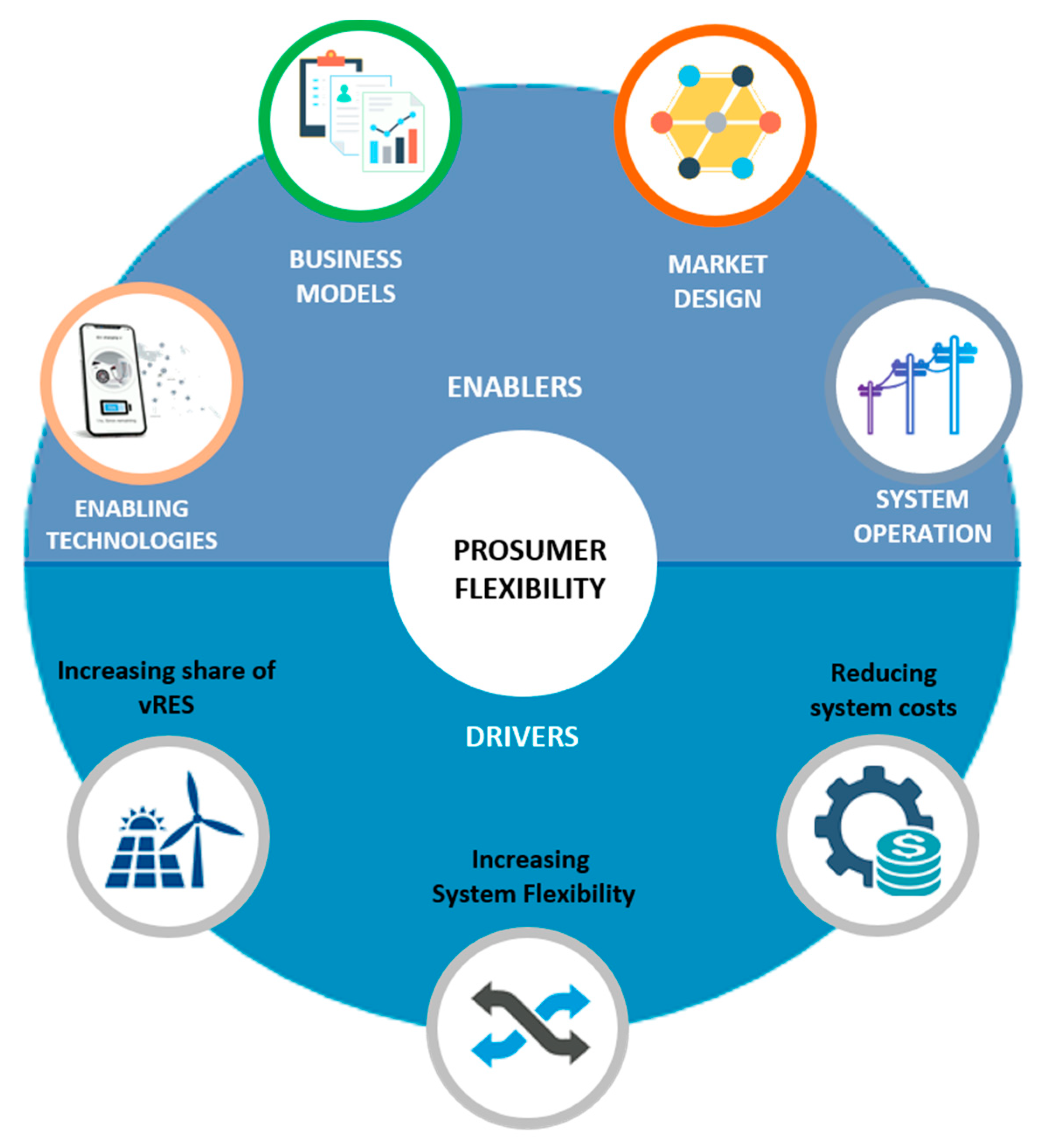
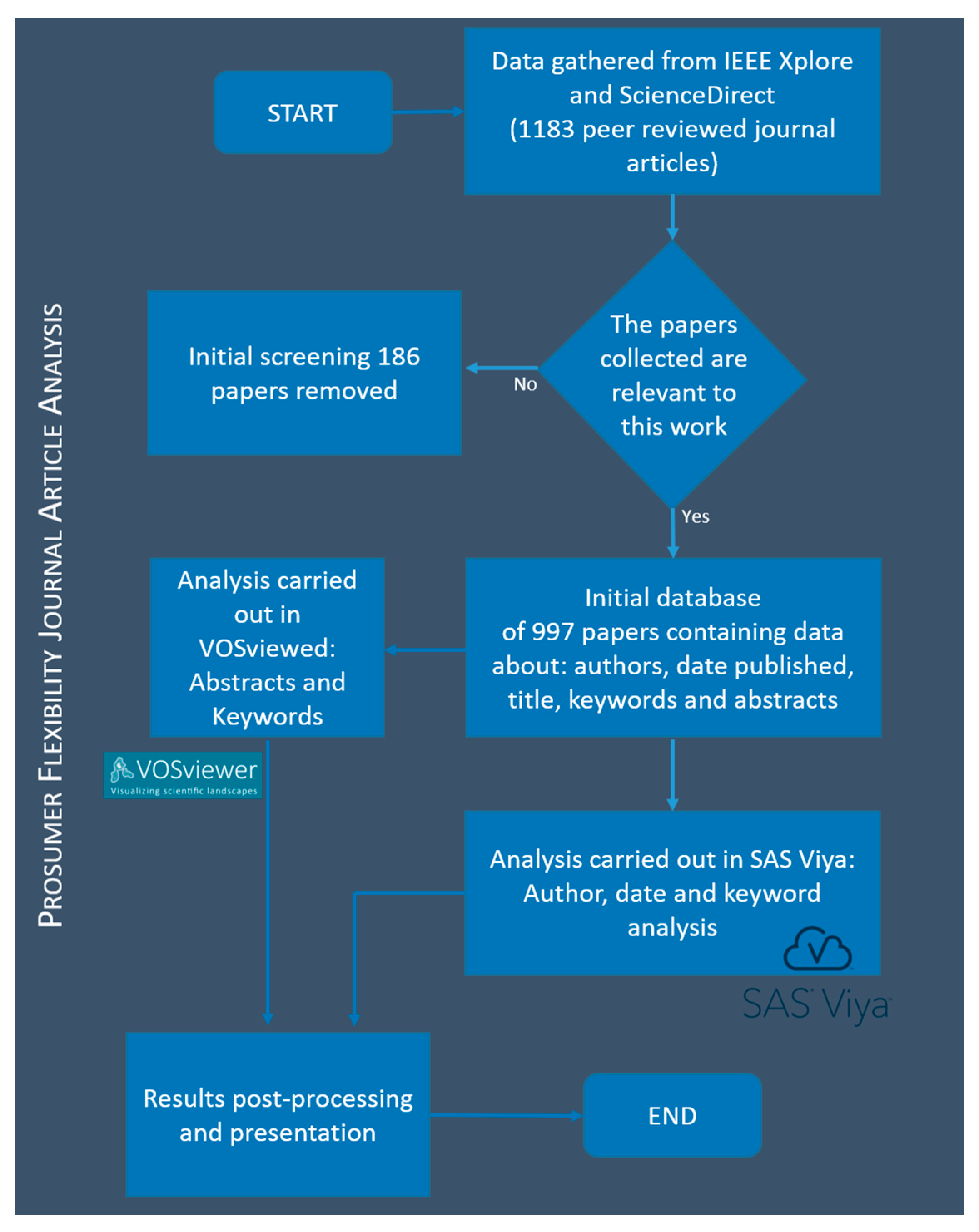
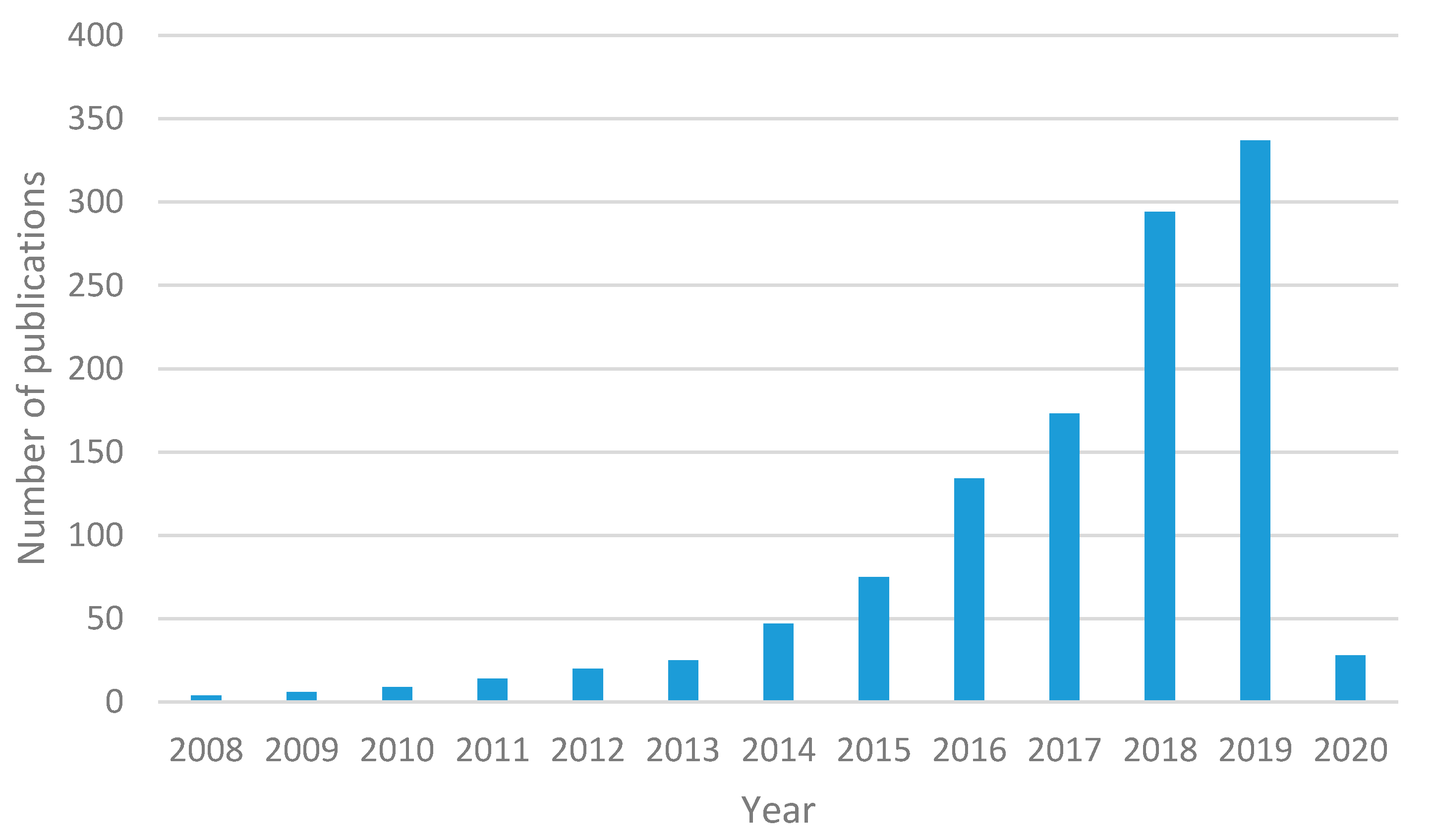
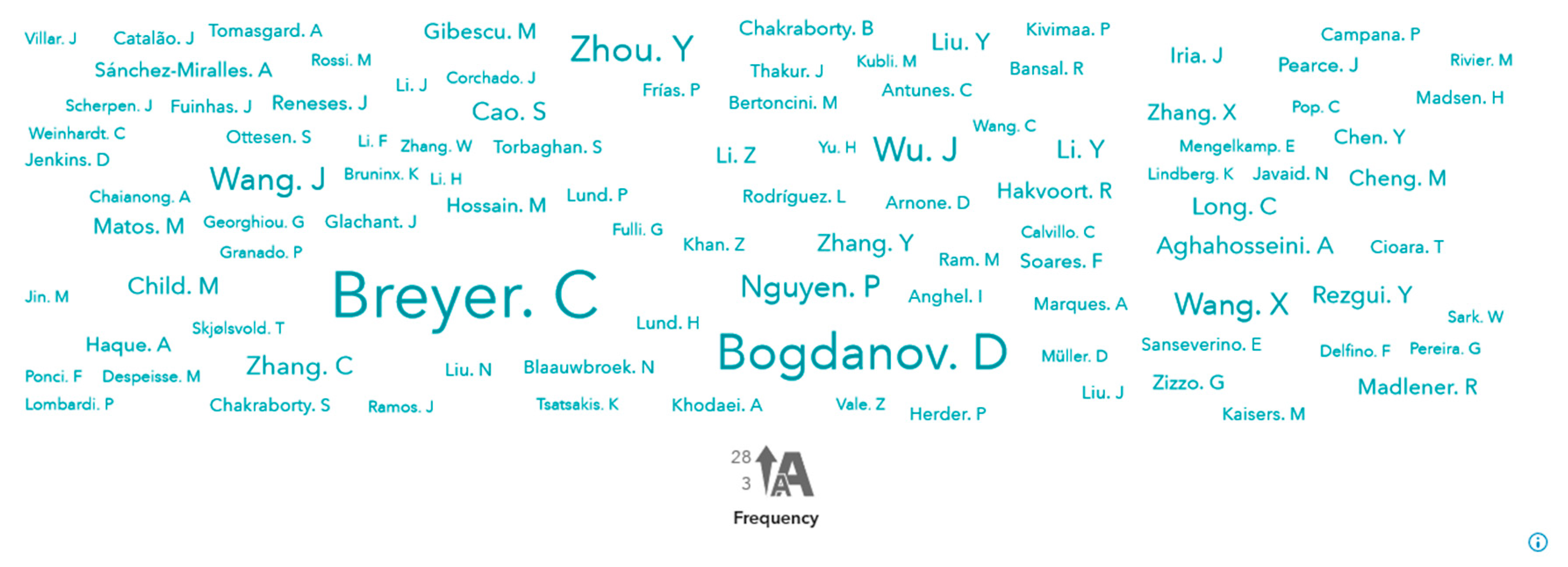
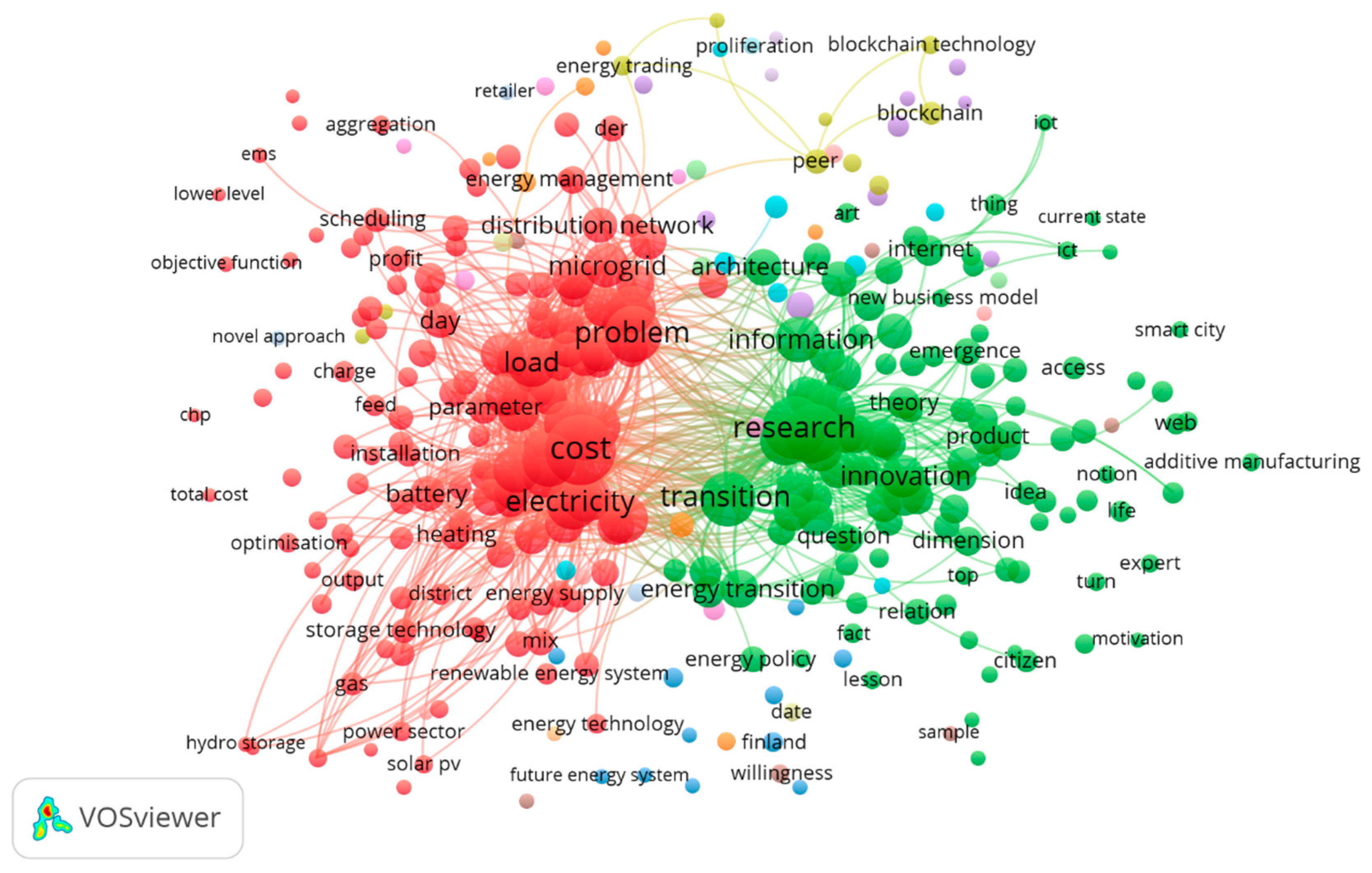
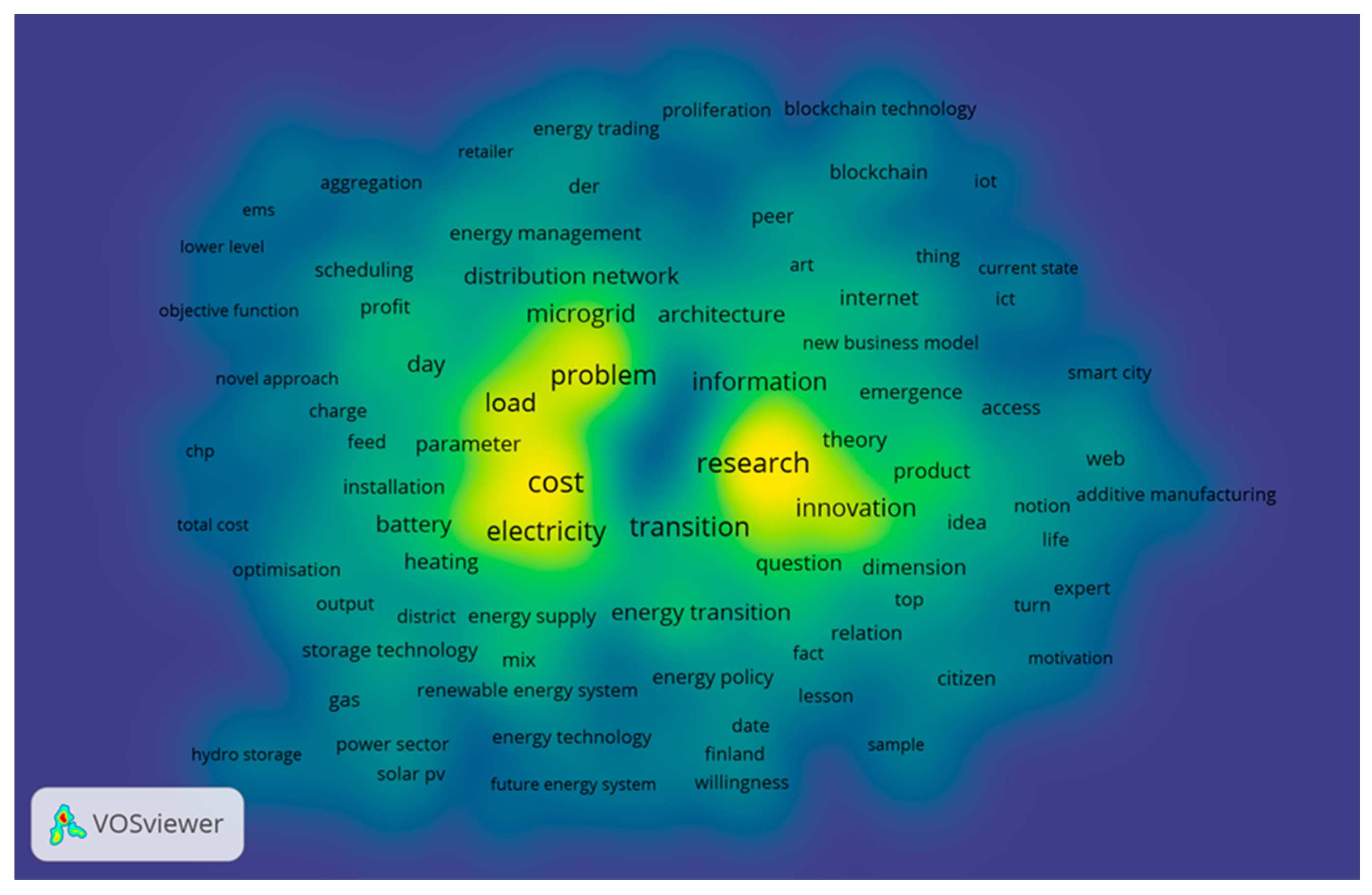
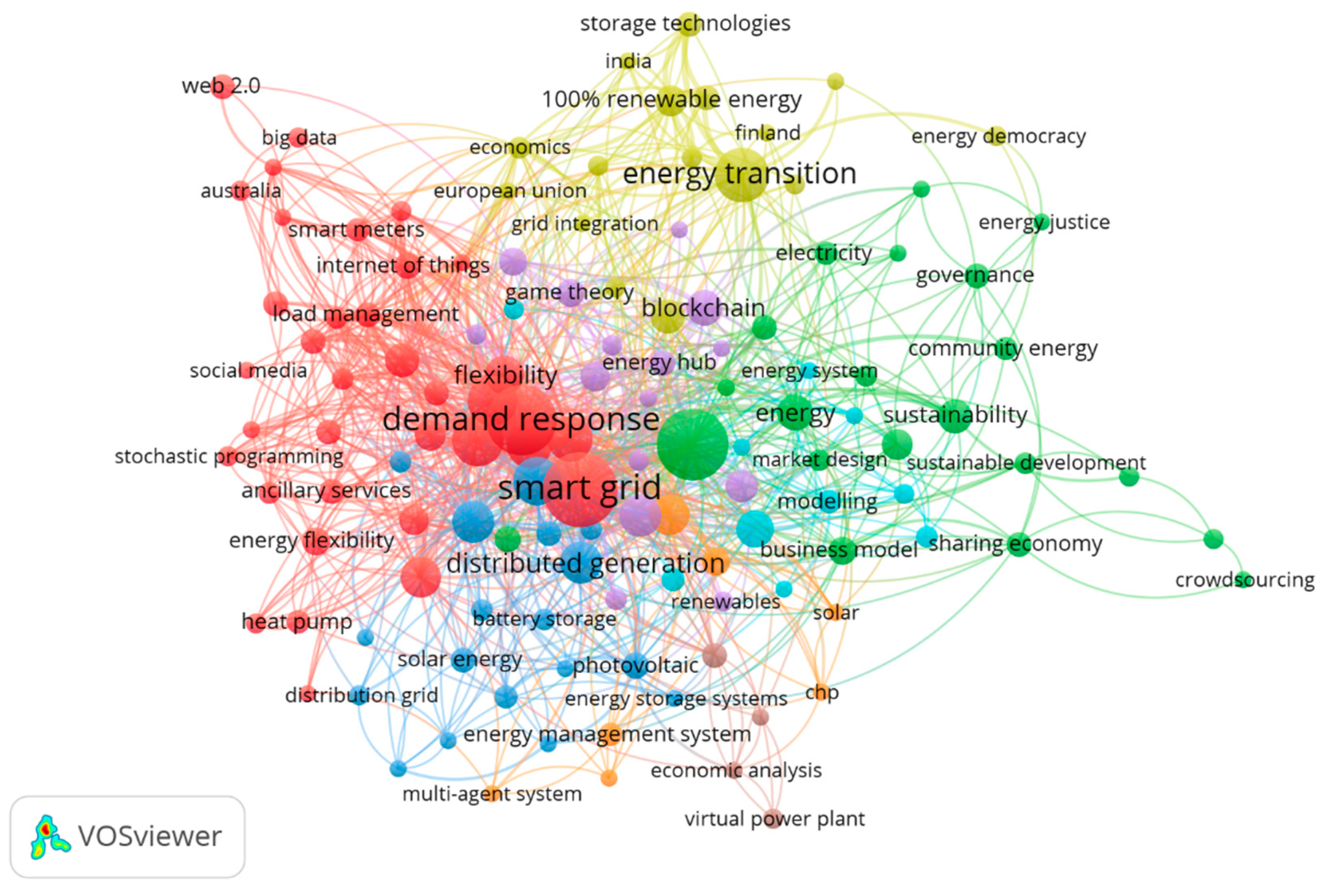
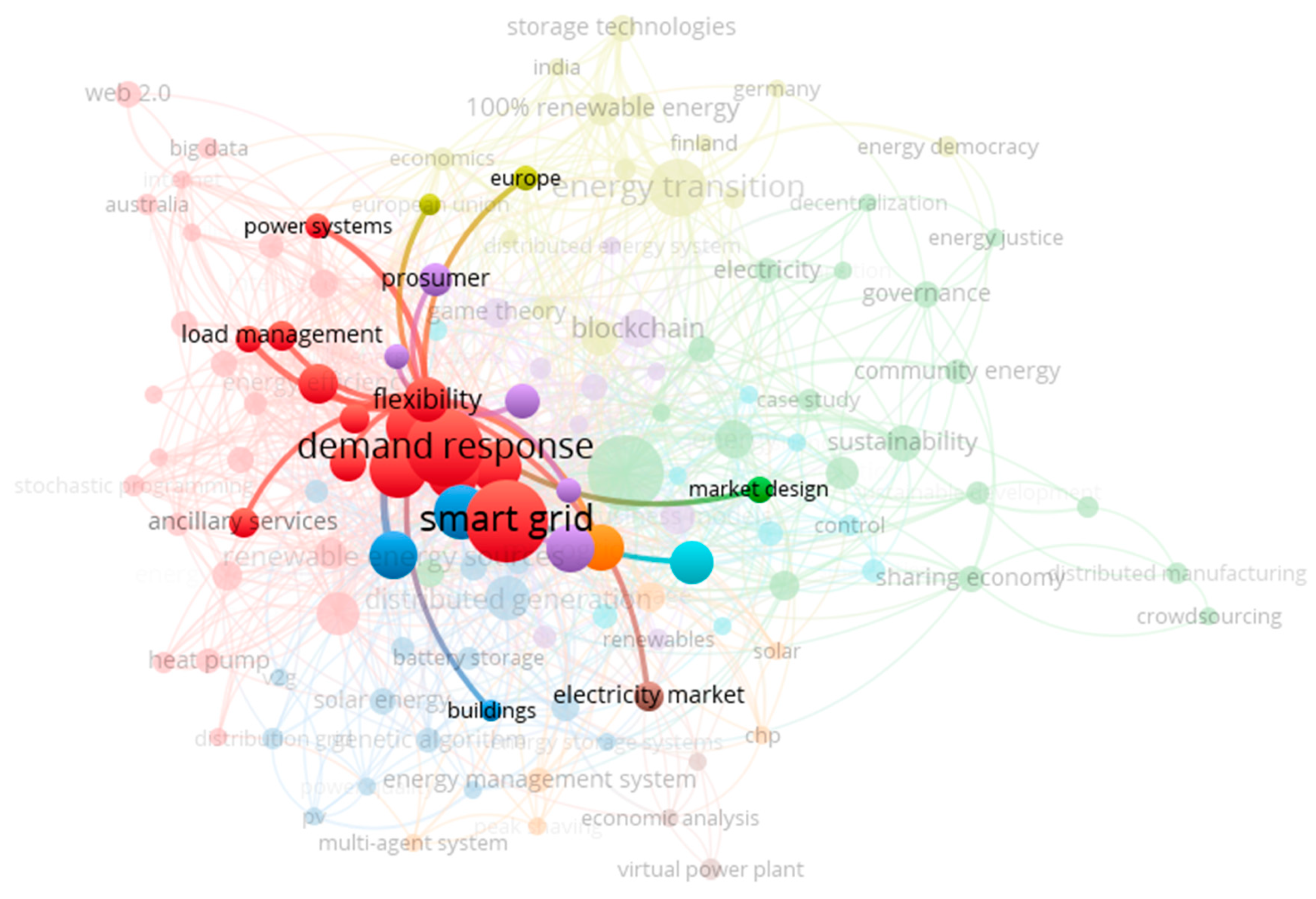
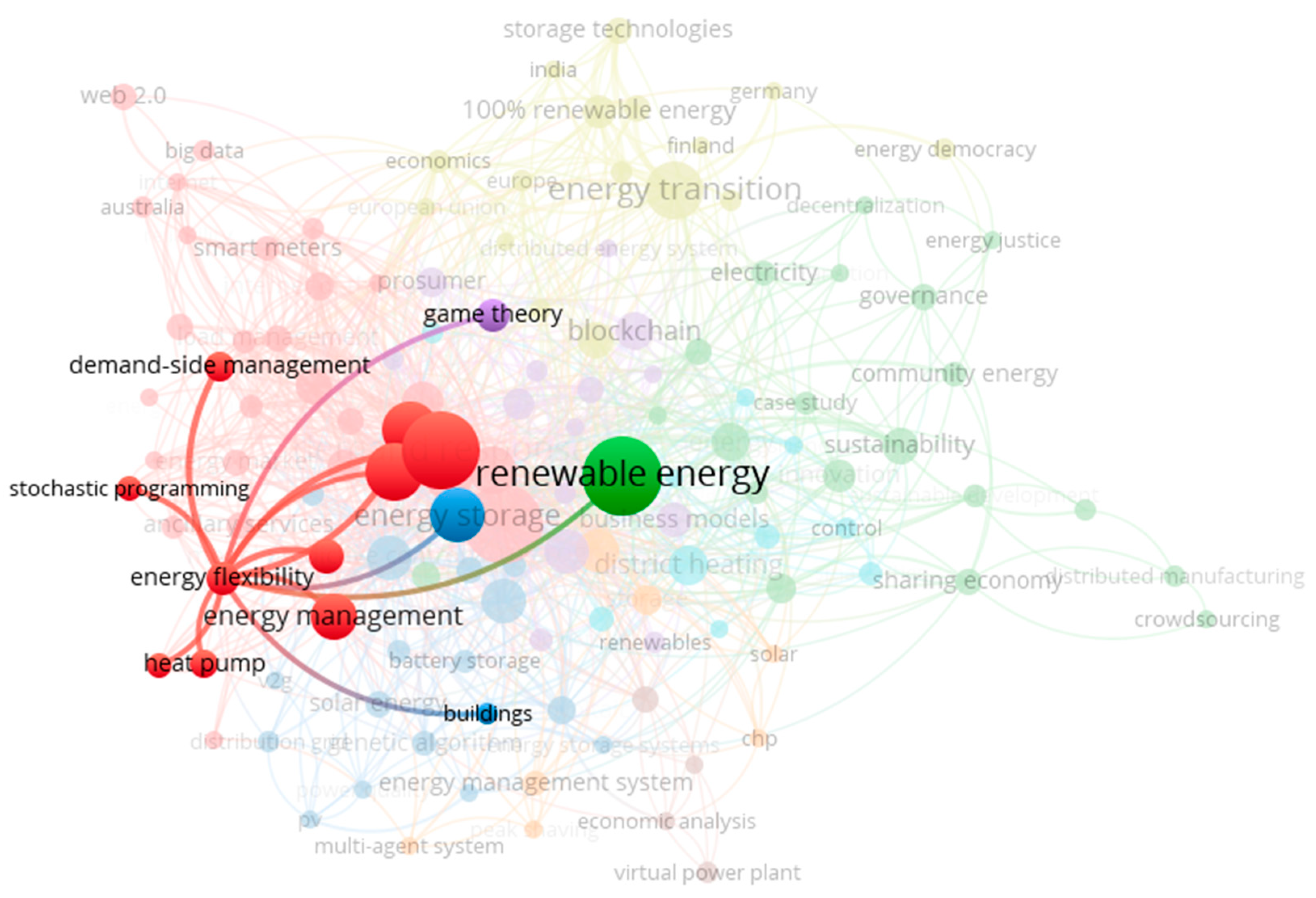
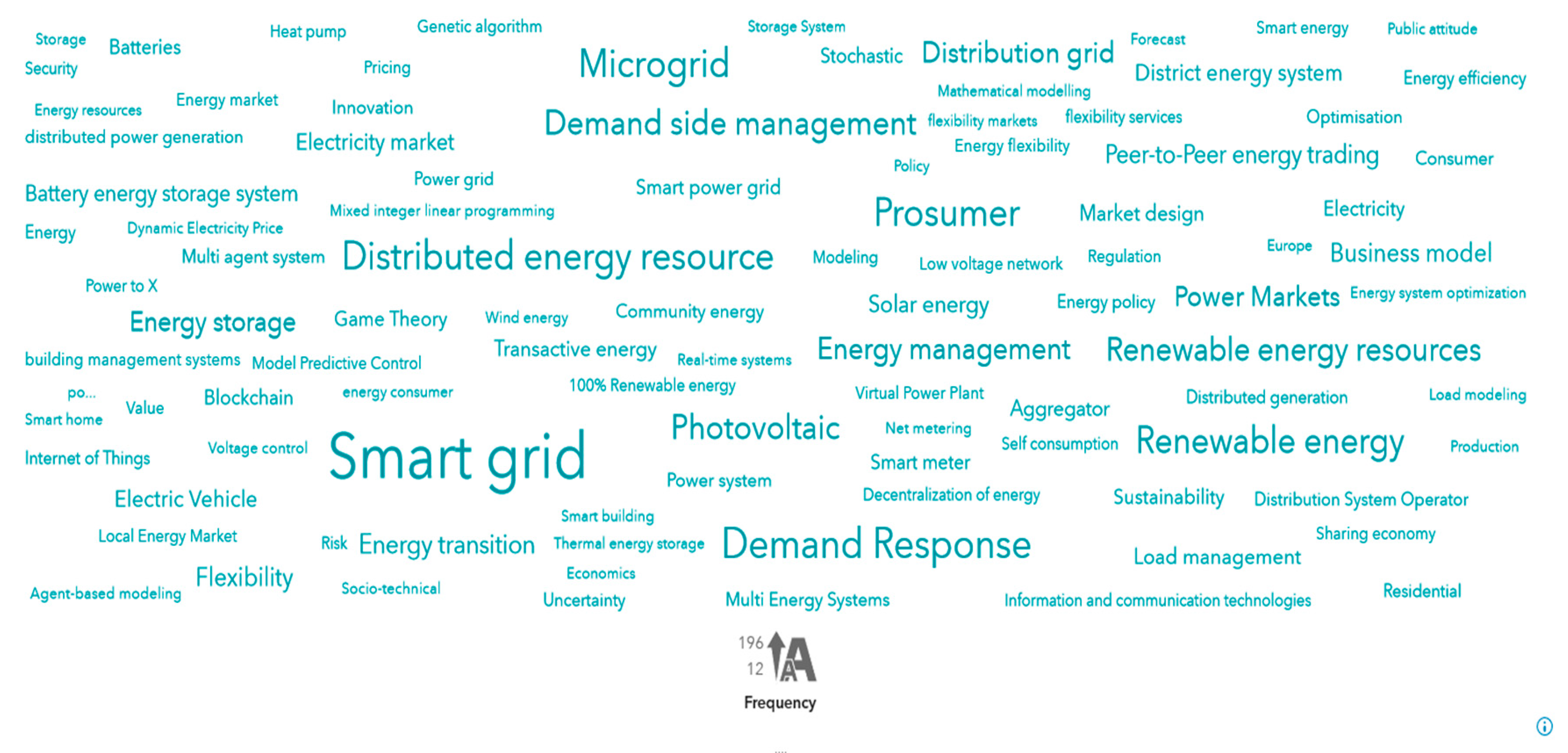

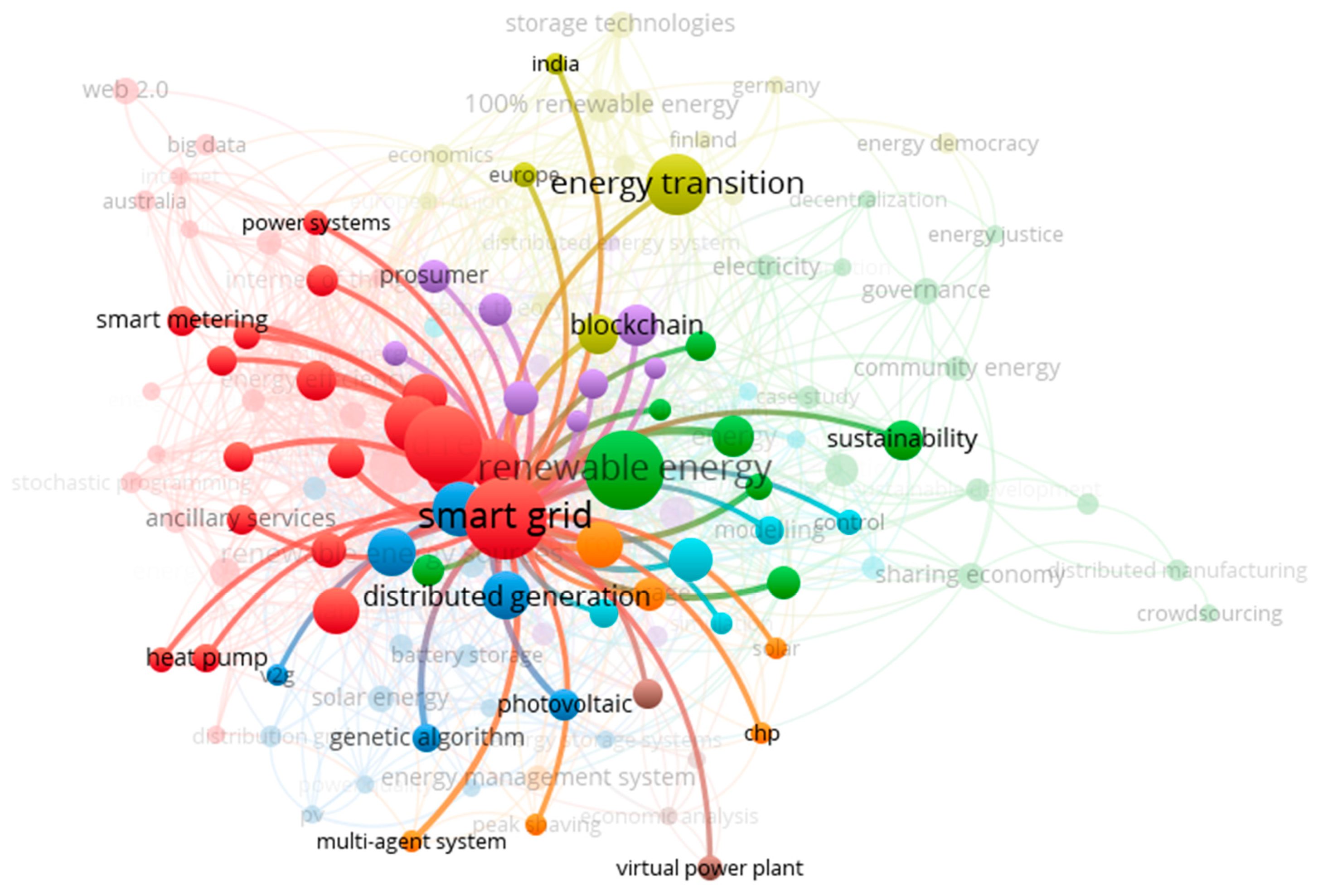
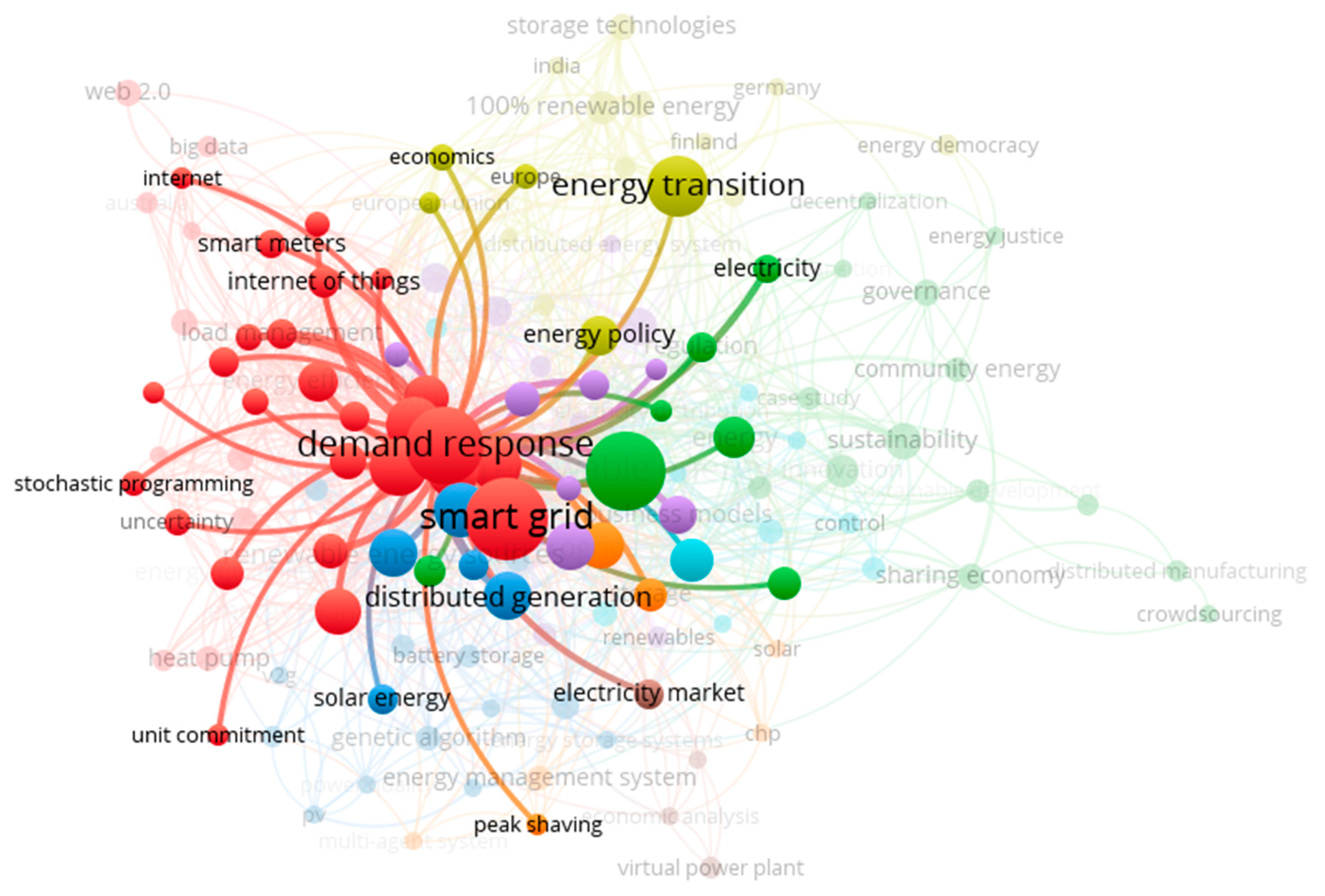
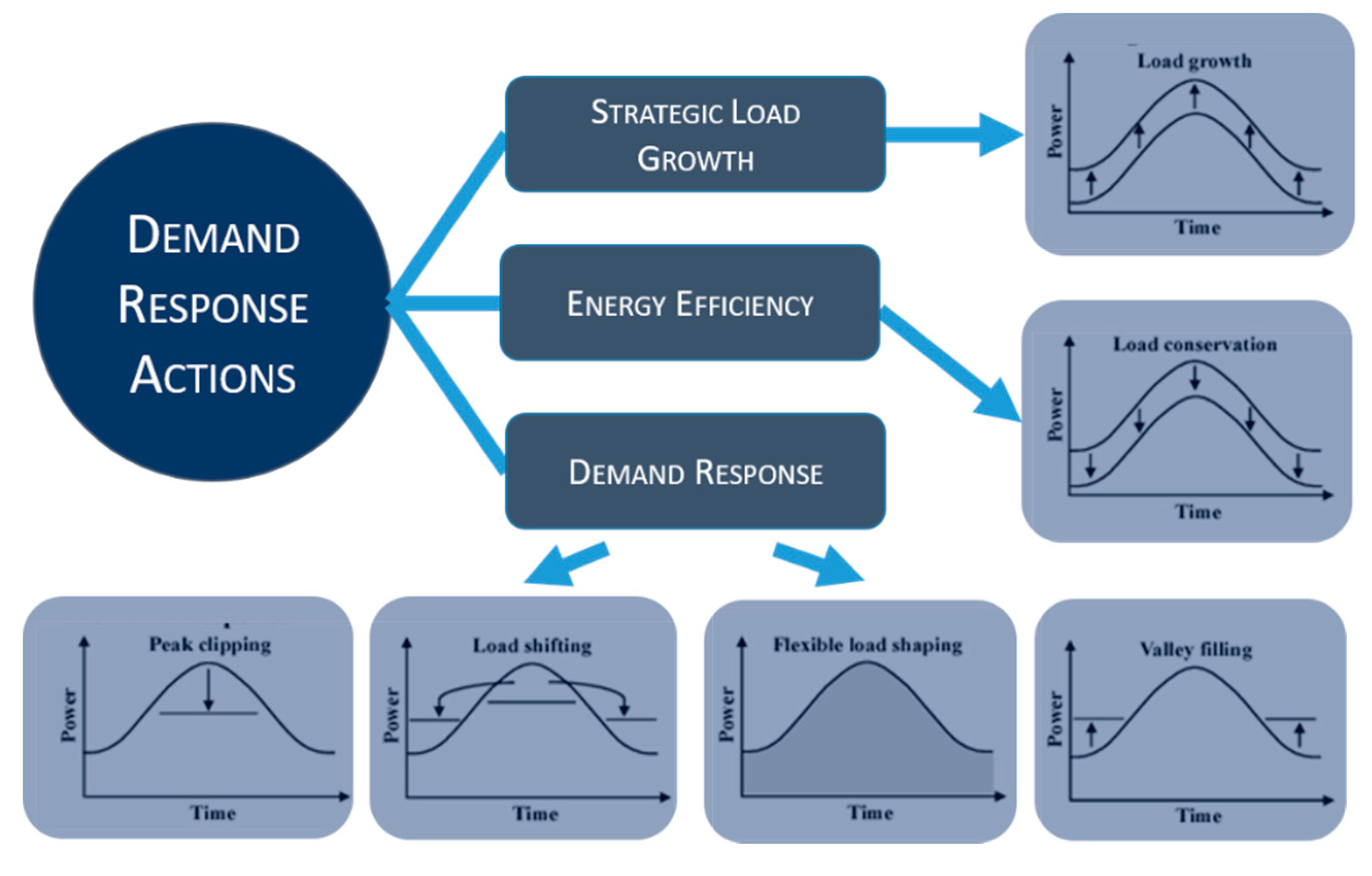
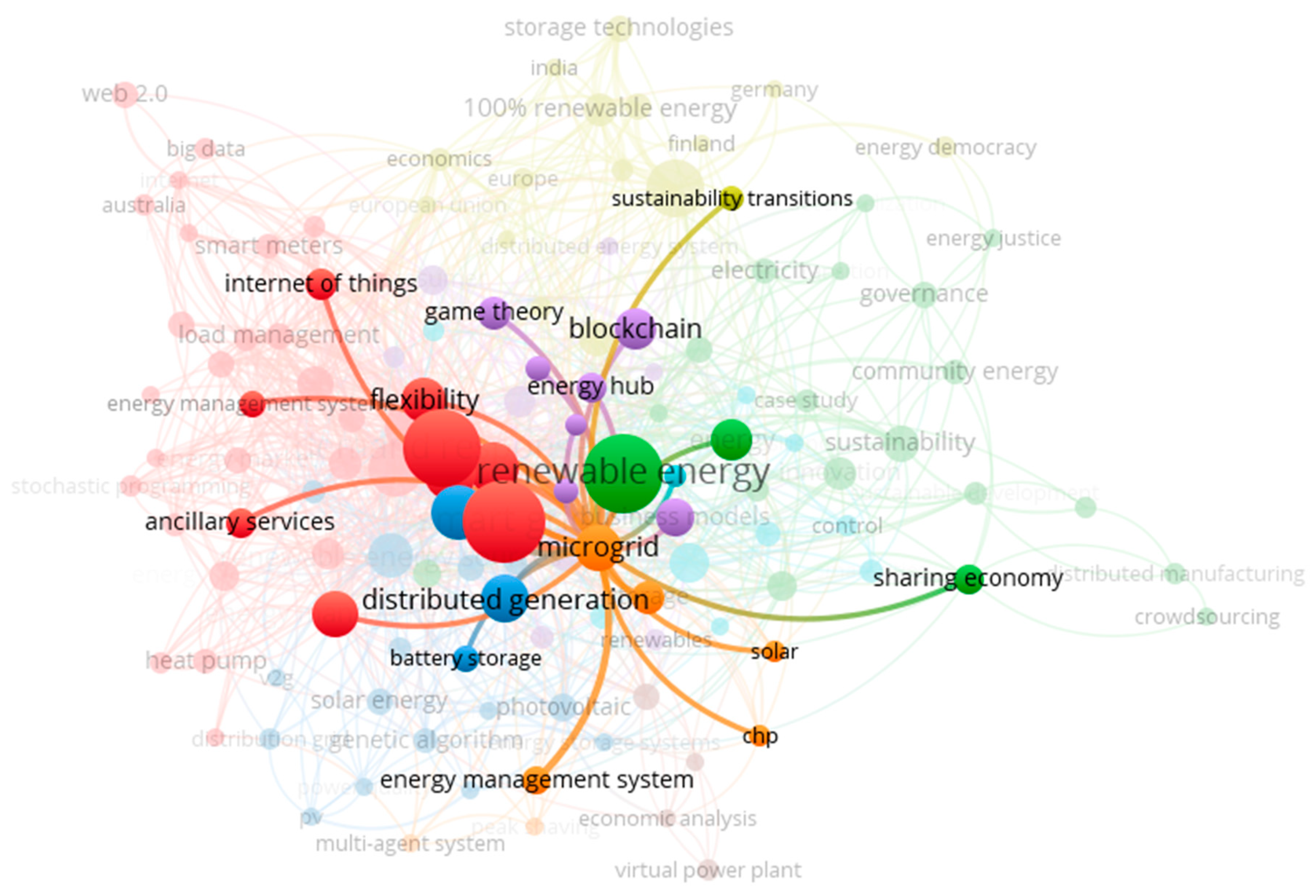
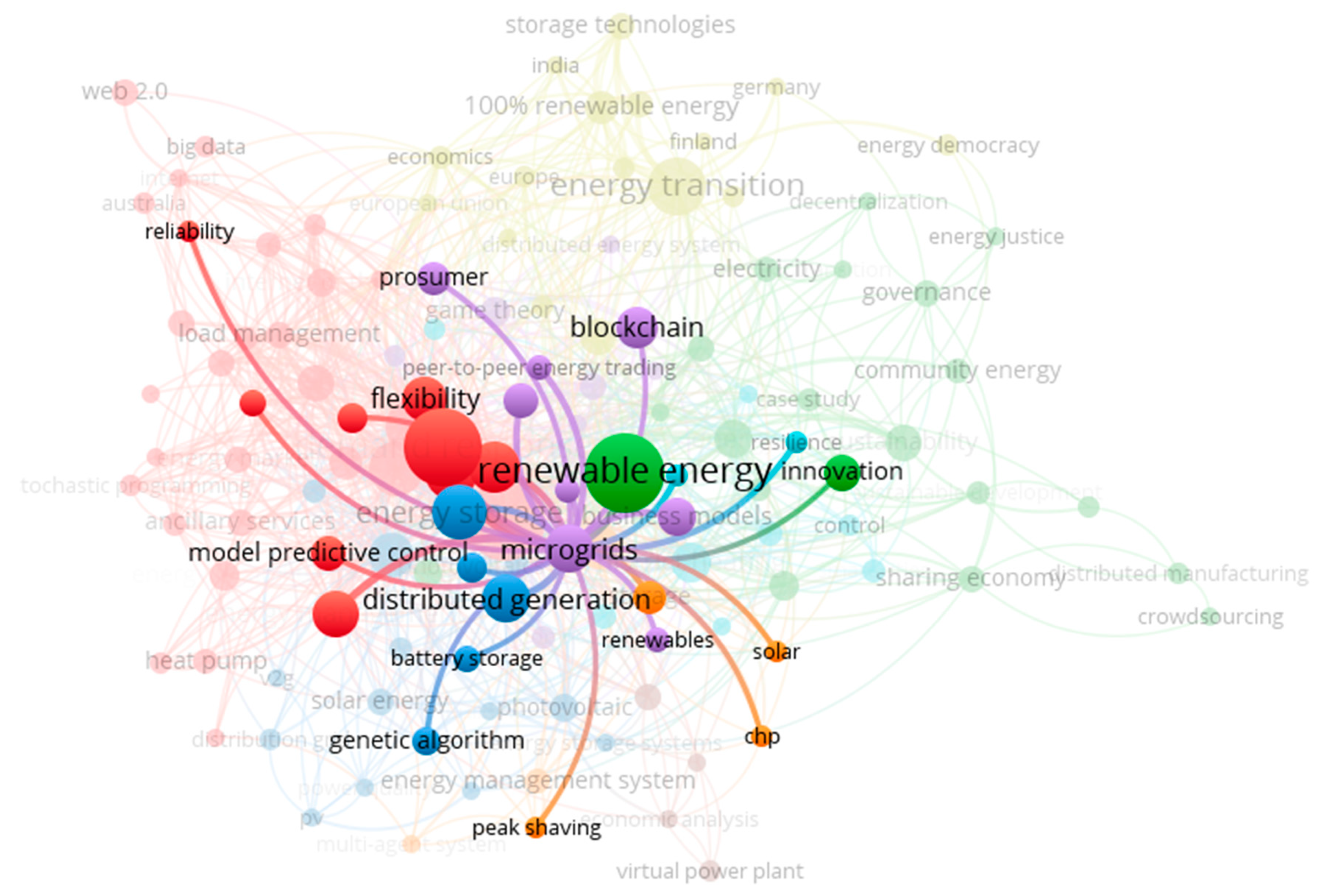
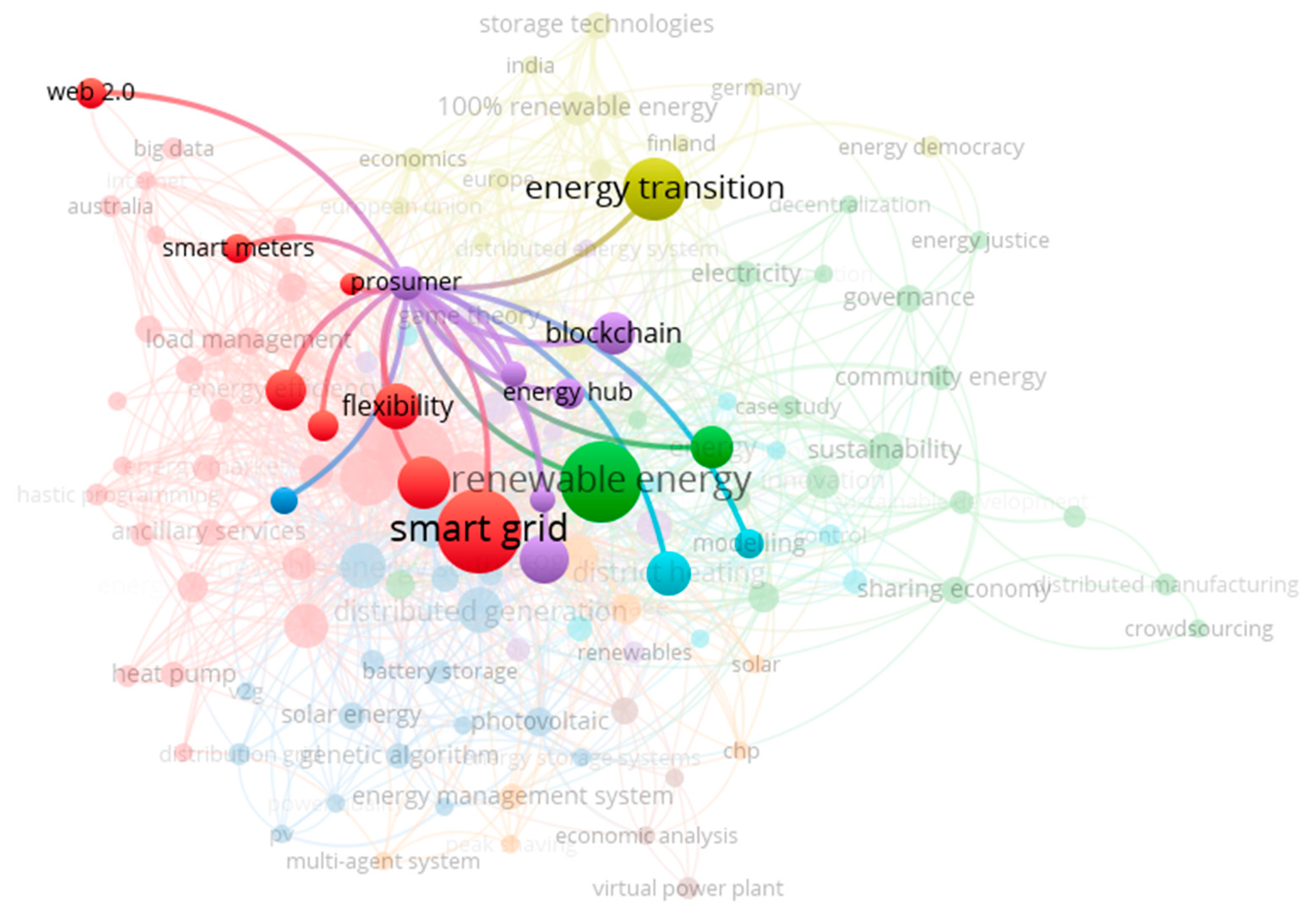
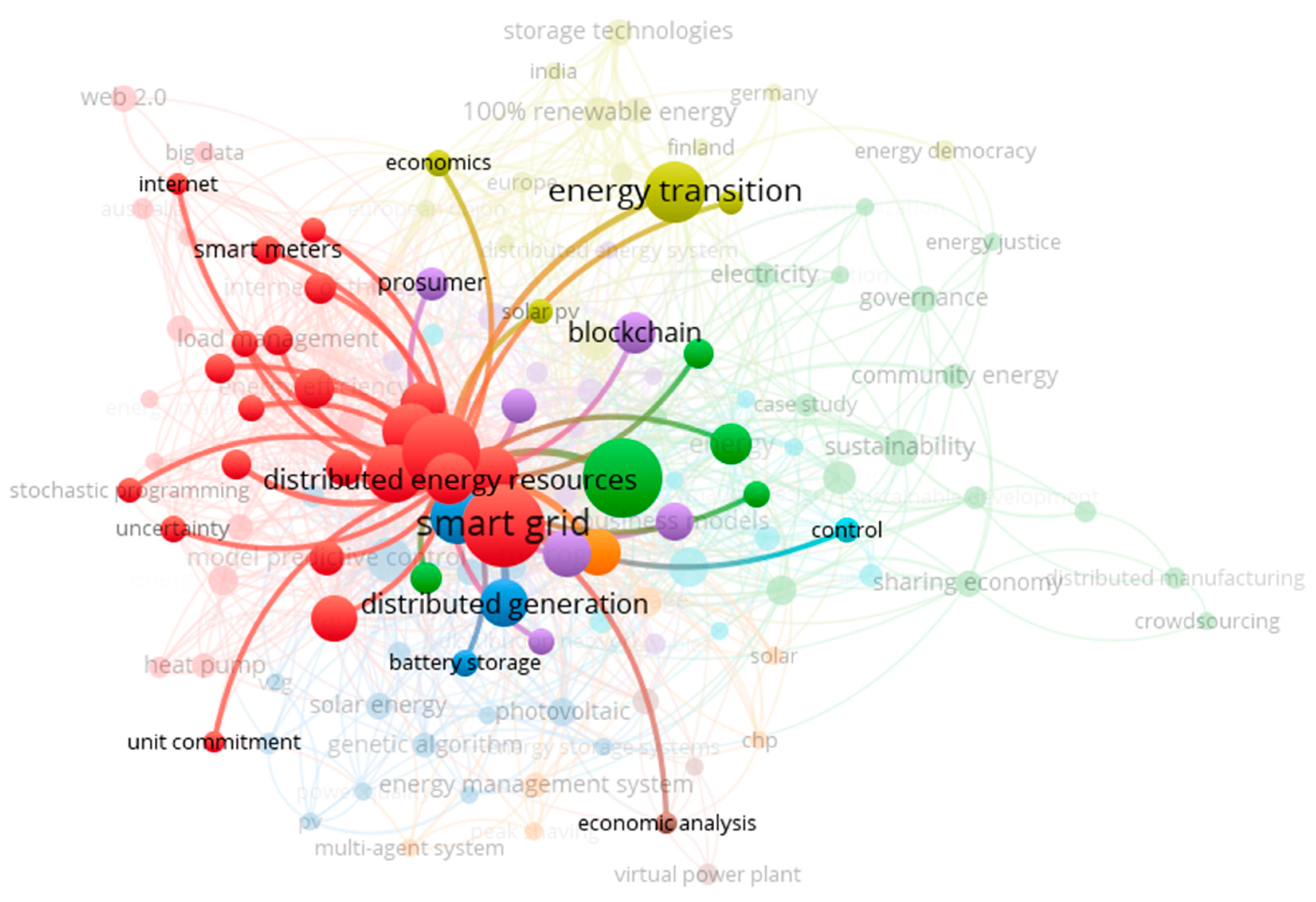
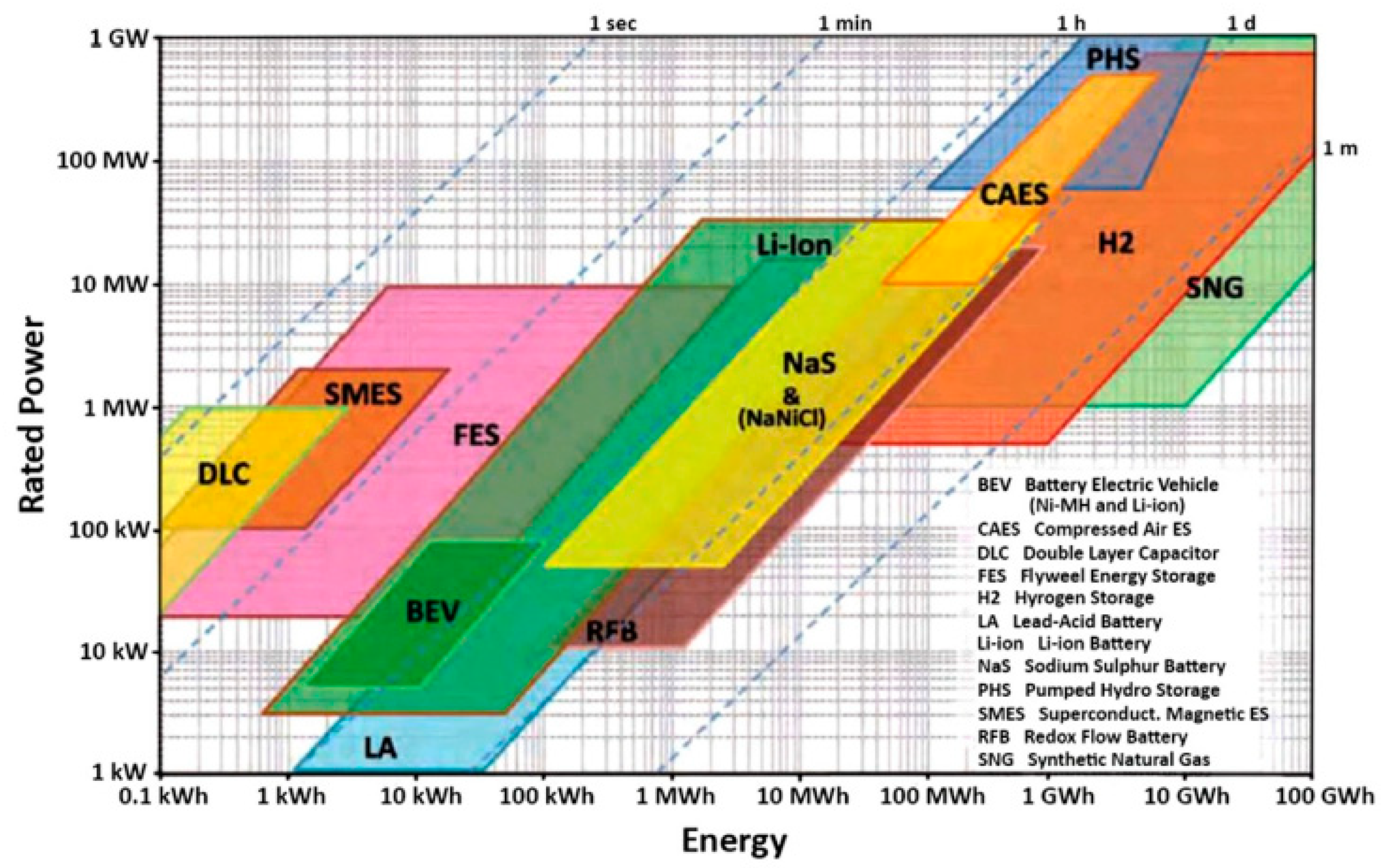
© 2020 by the authors. Licensee MDPI, Basel, Switzerland. This article is an open access article distributed under the terms and conditions of the Creative Commons Attribution (CC BY) license (http://creativecommons.org/licenses/by/4.0/).
Share and Cite
Gough, M.; F. Santos, S.; Javadi, M.; Castro, R.; P. S. Catalão, J. Prosumer Flexibility: A Comprehensive State-of-the-Art Review and Scientometric Analysis. Energies 2020, 13, 2710. https://doi.org/10.3390/en13112710
Gough M, F. Santos S, Javadi M, Castro R, P. S. Catalão J. Prosumer Flexibility: A Comprehensive State-of-the-Art Review and Scientometric Analysis. Energies. 2020; 13(11):2710. https://doi.org/10.3390/en13112710
Chicago/Turabian StyleGough, Matthew, Sérgio F. Santos, Mohammed Javadi, Rui Castro, and João P. S. Catalão. 2020. "Prosumer Flexibility: A Comprehensive State-of-the-Art Review and Scientometric Analysis" Energies 13, no. 11: 2710. https://doi.org/10.3390/en13112710
APA StyleGough, M., F. Santos, S., Javadi, M., Castro, R., & P. S. Catalão, J. (2020). Prosumer Flexibility: A Comprehensive State-of-the-Art Review and Scientometric Analysis. Energies, 13(11), 2710. https://doi.org/10.3390/en13112710






